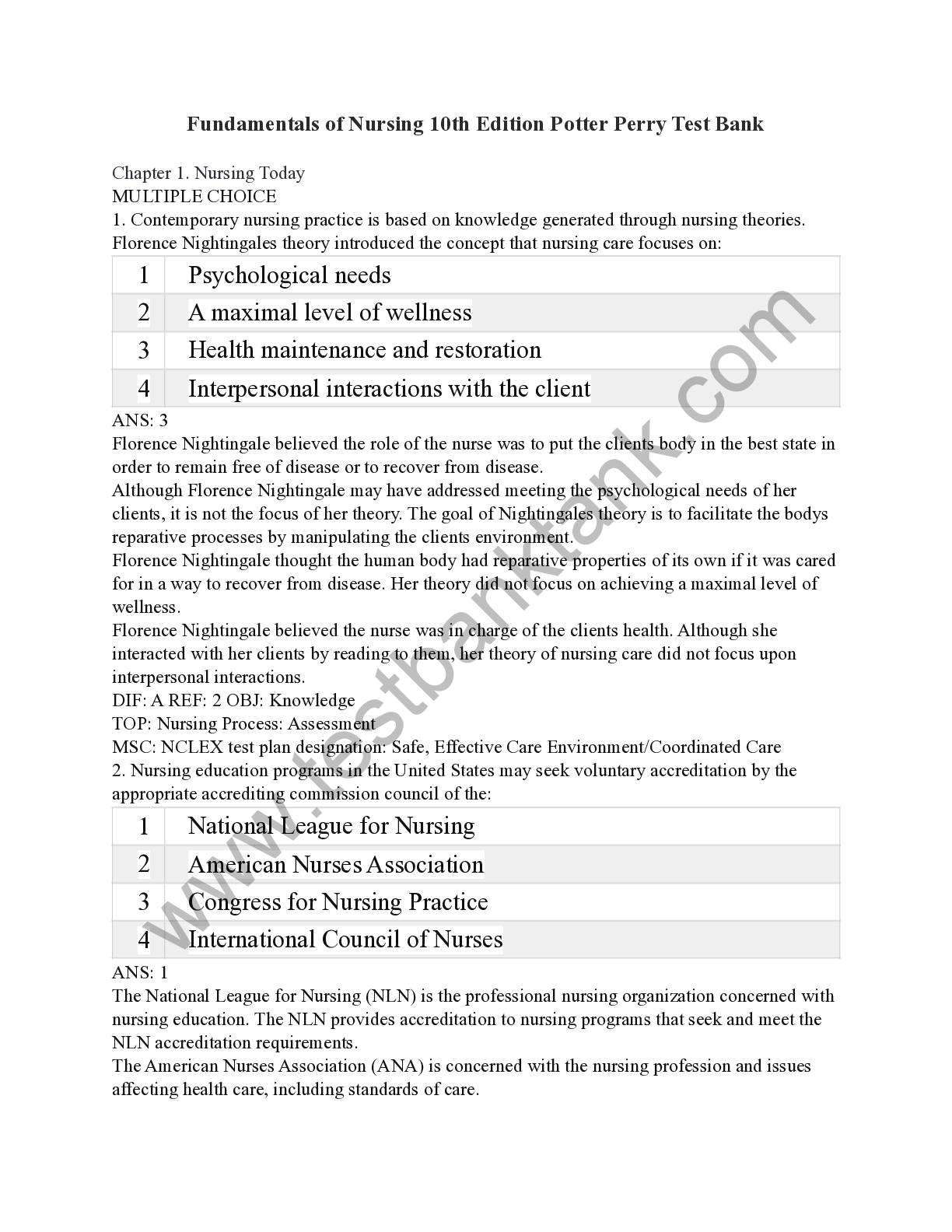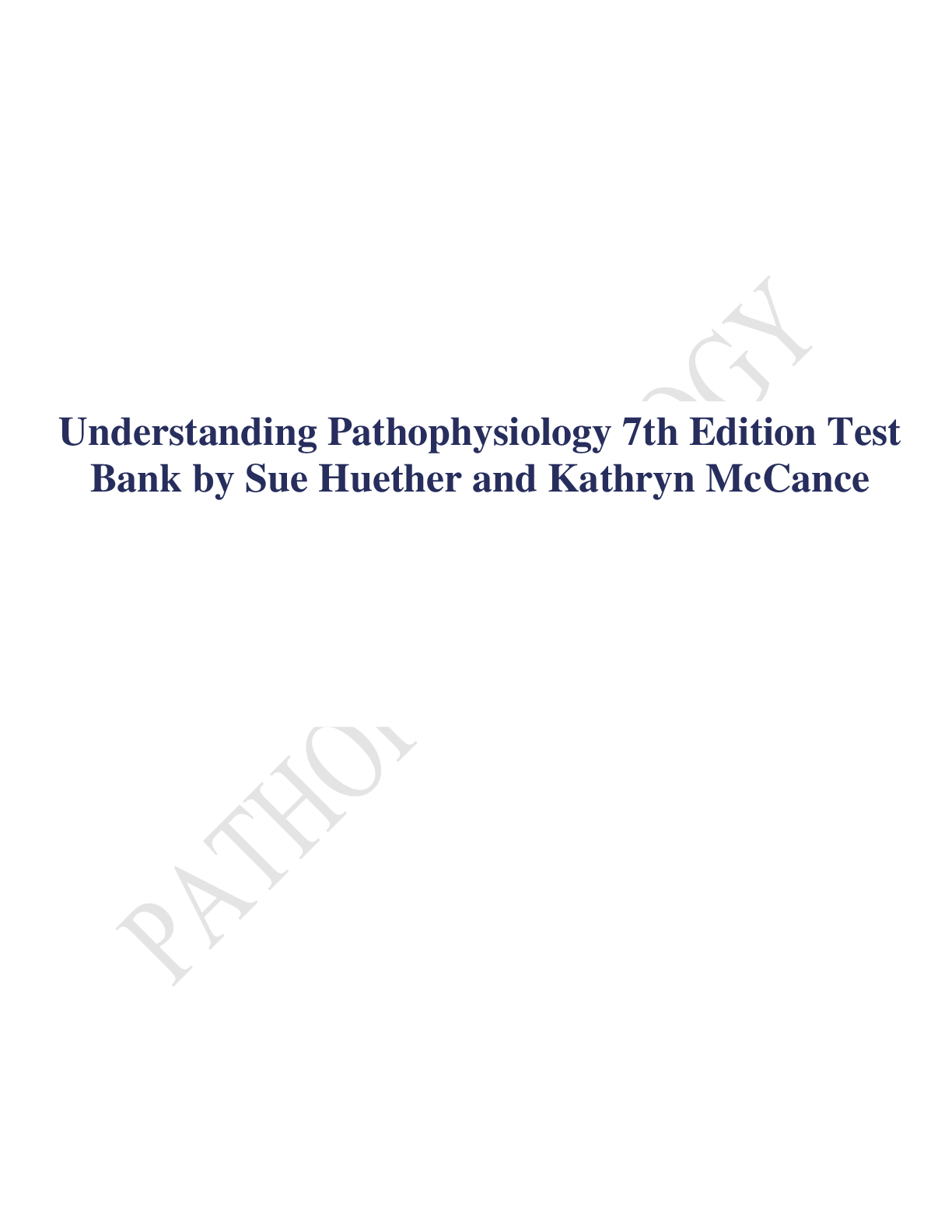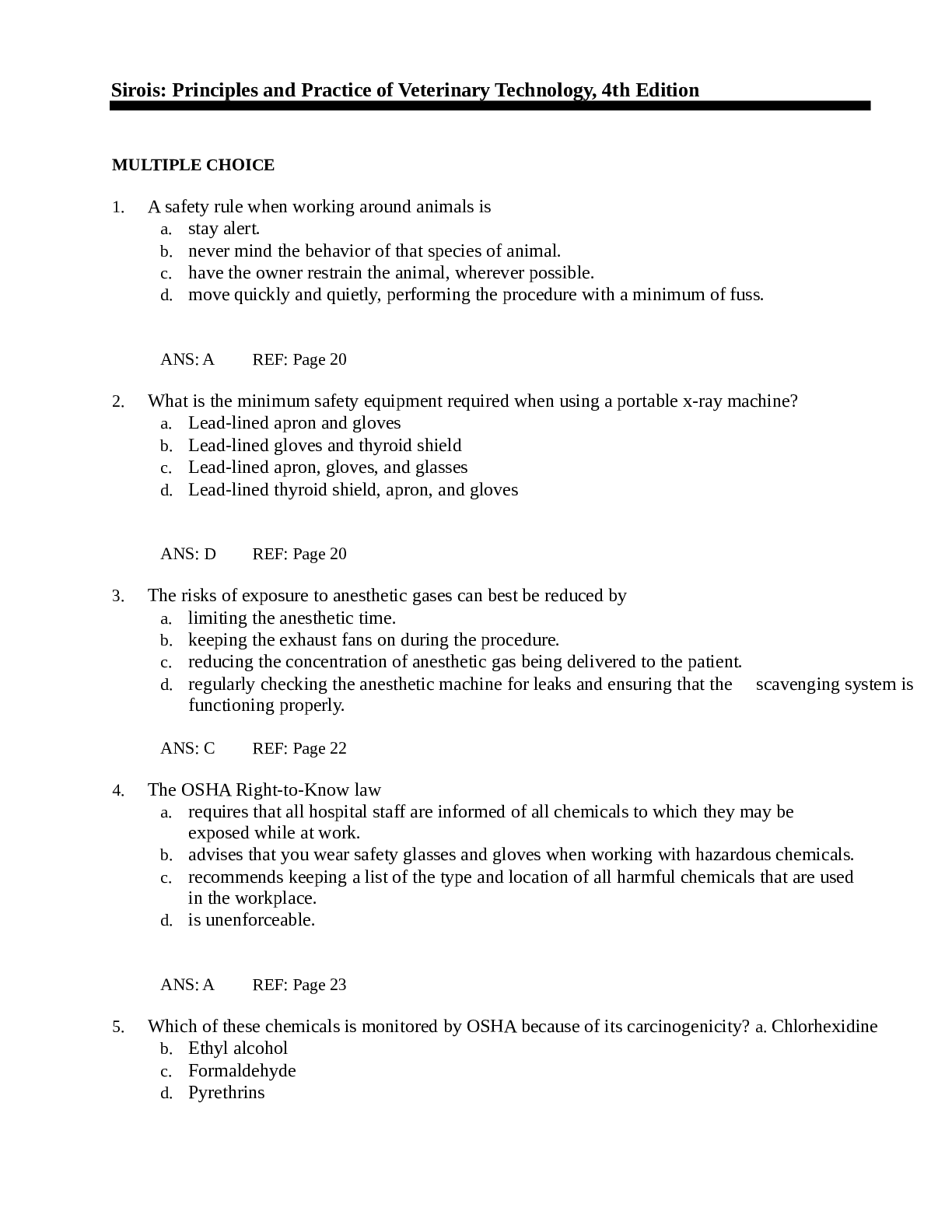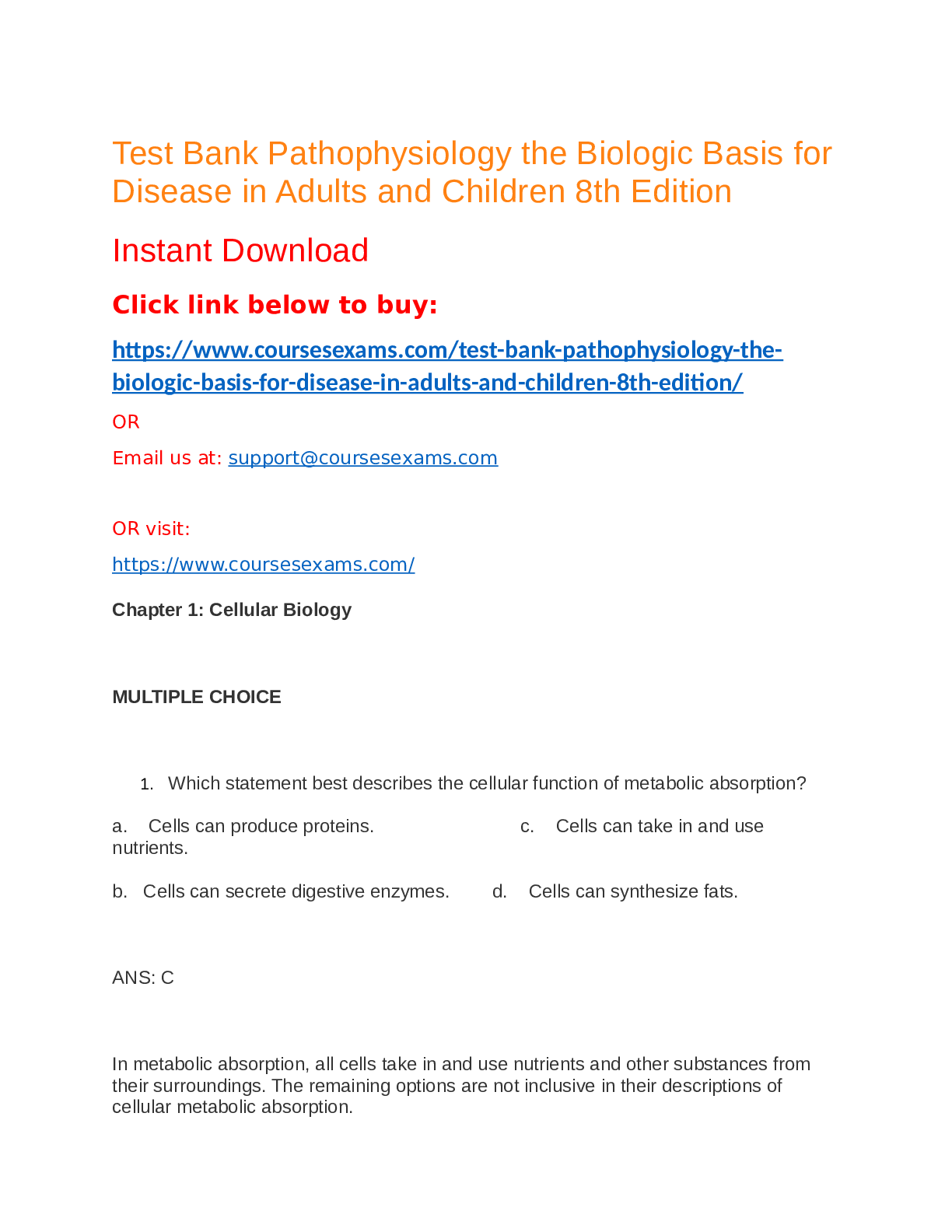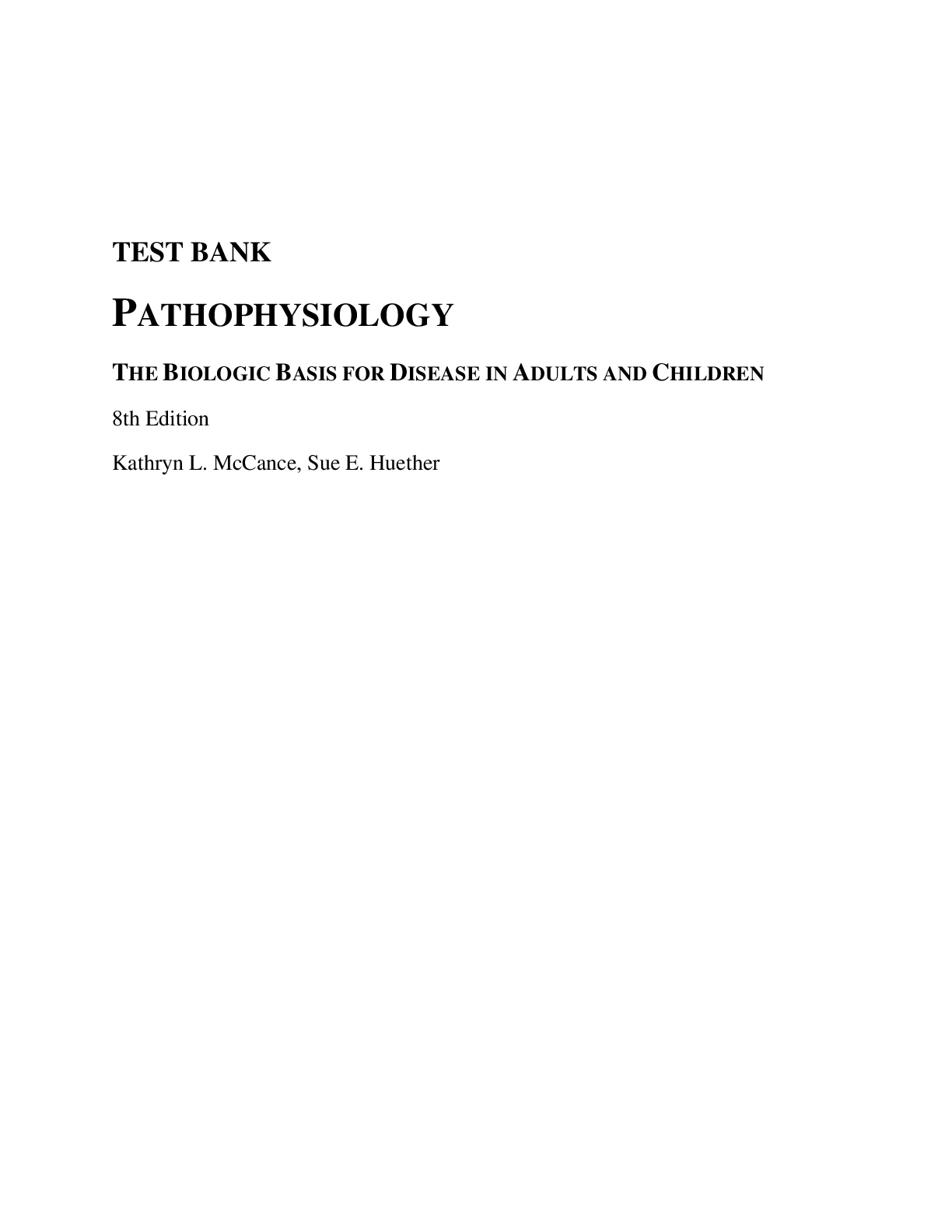Pathophysiology > TEST BANK > NURS 5315 Pathophysiology The Biologic Basis for Disease in Adults and Children 8th Edition (All)
NURS 5315 Pathophysiology The Biologic Basis for Disease in Adults and Children 8th Edition
Document Content and Description Below
Pathophysiology_The_Biologic_Basis_for_Disease_in_Adults_and_Children_8th_Edition - University of Texas | Test Bank Chapter 1 - Cellular Biology 3 Chapter 2 - Altered Cellular and Tissue Biology Envir... onmental Agents 16 Chapter 3 - The Cellular Environment Fluids and Electrolytes Acids and Bases 28 Chapter 4 - Genes and Genetic Diseases 41 Chapter 5 - Genes Environment-Lifestyle and Common Diseases 51 Chapter 6 - Epigenetics and Disease 59 Chapter 7 - Innate Immunity Inflammation 64 Chapter 8 - Adaptive Immunity 78 Chapter 9 - Alterations in Immunity and Inflammation 89 Chapter 10 - Infection 102 Chapter 11 - Stress and Disease 110 Chapter 12 - Cancer Biology 117 Chapter 13 - Cancer Epidemiology 129 Chapter 14 - Cancer in Children 135 Chapter 15 - Structure and Function of the Neurologic System 140 Chapter 16 - Pain Temperature Regulation Sleep and Sensory Function 151 Chapter 17 - Alterations in Cognitive Systems Cerebral Hemodynamics and Motor Function 165 Chapter 18 - Disorders of the Central and Peripheral Nervous Systems and the Neuromuscular Junction 179 Chapter 19 - Neurobiology of Schizophrenia Mood Disorders and Anxiety Disorders 189 Chapter 20 - Alterations of Neurologic Function in Children 195 Chapter 21 - Mechanisms of Hormonal Regulation 202 Chapter 22 - Alterations of Hormonal Regulation 211 Chapter 23 - Obesity and Disorders of Nutrition NEW 223 Chapter 24 - Structure and Function of the Reproductive Systems 228 Chapter 25 - Alterations of the Female Reproductive System 237 Chapter 26 - Alterations of the Male Reproductive System 246 Pathophysiology The Biologic Basis for Disease in Adults and Children 8th Edition 34Chapter 27 - Sexually Transmitted Infections 252 Chapter 28 - Structure and Function of the Hematologic System 260 Chapter 29 - Alterations of Erythrocyte Platelet and Hemostatic Function 270 Chapter 30 - Alterations of Leukocyte and Lymphoid Function 280 Chapter 31 - Alterations of Hematologic Function in Children 287 Chapter 32 - Structure and Function of the Cardiovascular and Lymphatic Systems 297 Chapter 33 - Alterations of Cardiovascular Function 309 Chapter 34 - Alterations of Cardiovascular Function in Children 323 Chapter 35 - Structure and Function of the Pulmonary System 331 Chapter 36 - Alterations of Pulmonary Function 341 Chapter 37 - Alterations of Pulmonary Function in Children 357 Chapter 38 - Structure and Function of the Renal and Urologic Systems 365 Chapter 39 - Alterations of Renal and Urinary Function 375 Chapter 40 - Alterations of Renal and Urinary Tract Function in Children 385 Chapter 41 - Structure and Function of the Digestive System 393 Chapter 42 - Alterations of Digestive Function 404 Chapter 43 - Alterations of Digestive Function in Children 415 Chapter 44 - Structure and Function of the Musculoskeletal System 424 Chapter 45 - Alterations of Musculoskeletal Function 436 Chapter 46 - Alterations of Musculoskeletal Function in Children 448 Chapter 47 - Structure Function and Disorders of the Integument 457 Chapter 48 - Alterations of the Integument in Children 468 Chapter 49 - Shock Multiple Organ Dysfunction Syndrome and Burns in Adults 476 Chapter 50 - Shock Multiple Organ Dysfunction Syndrome and Burns in Children 483 Pathophysiology The Biologic Basis for Disease in Adults and Children 8th Edition 34Chapter 01: Cellular Biology McCance/Huether: Pathophysiology: The Biologic Basis of Disease in Adults and Children, 8th Edition MULTIPLE CHOICE - - - - - - - - - - - - - 1. Which statement best describes the cellular function of metabolic absorption? a. Cells can produce proteins. b. Cells can secrete digestive enzymes. c. Cells can take in and use nutrients. d. Cells can synthesize fats. ANS: C In metabolic absorption, all cells take in and use nutrients and other substances from their surroundings. The remaining options are not inclusive in their descriptions of cellular metabolic absorption. PTS: 1 DIF: Cognitive Level: Remembering 2. Where is most of a cell’s genetic information, including RNA and DNA, contained? a. Mitochondria b. Ribosome c. Nucleolus d. Lysosome ANS: C The nucleus contains the nucleolus, a small dense structure composed largely of RNA, most of the cellular DNA, and the DNA-binding proteins, such as the histones, which regulate its activity. The mitochondria are responsible for cellular respiration and energy production. Ribosomes’ chief function is to provide sites for cellular protein synthesis. Lysosomes function as the intracellular digestive system. PTS: 1 DIF: Cognitive Level: Remembering 3. Which component of the cell produces hydrogen peroxide (H2O2) by using oxygen to remove hydrogen atoms from specific substrates in an oxidative reaction? a. Lysosomes b. Peroxisomes c. Ribosomes d. Endosome ANS: B Chapter 1 - Cellular Biology 3 Pathophysiology The Biologic Basis for Disease in Adults and Children 8th Edition 34Peroxisomes are so named because they usually contain enzymes that use oxygen to remove hydrogen atoms from specific substrates in an oxidative reaction that produces H2O2, which is a powerful oxidant and potentially destructive if it accumulates or escapes from peroxisomes. Ribosomes are RNA-protein complexes (nucleoproteins) that are synthesized in the nucleolus and secreted into the cytoplasm through pores in the nuclear envelope called nuclear pore complexes. Lysosomes are saclike structures that originate from the Golgi complex and contain more than 40 digestive enzymes called hydrolases, which catalyze bonds in proteins, lipids, nucleic acids, and carbohydrates. An endosome is a vesical that has been pinched off from the cellular membrane. PTS: 1 DIF: Cognitive Level: Remembering 4. Which cell component is capable of cellular autodigestion when it is released during cell injury? a. Ribosome b. Golgi complex c. Smooth endoplasmic reticulum d. Lysosomes ANS: D The lysosomal membrane acts as a protective shield between the powerful digestive enzymes within the lysosome and the cytoplasm, preventing their leakage into the cytoplasmic matrix. Disruption of the membrane by various treatments or cellular injury leads to a release of the lysosomal enzymes, which can then react with their specific substrates, causing cellular self-digestion. The chief function of a ribosome is to provide sites for cellular protein synthesis. The Golgi complex is a network of flattened, smooth vesicles and membranes often located near the cell nucleus. The smooth endoplasmic reticulum is involved in steroid hormone production and removing toxic substances from the cell. PTS: 1 DIF: Cognitive Level: Remembering 5. Which cAMP-mediated response is related to antidiuretic hormone? a. Increased heart rate and force of contraction b. Secretion of cortisol c. Increased retention of water d. Breakdown of fat ANS: C Antidiuretic hormone leads to increased retention of water in the body. Epinephrine causes increases in heart rate and force of contraction. Increased cortisol secretion is due to ACTH. Breakdown of fat is due to glucagon. PTS: 1 DIF: Cognitive Level: Remembering 6. During which phase of the cell cycle is DNA synthesized? a. G1 b. S c. G2 d. M ANS: B Chapter 1 - Cellular Biology 4 Pathophysiology The Biologic Basis for Disease in Adults and Children 8th Edition 34The four designated phases of the cell cycle are: (1) the G1 phase (G = gap), which is the period between the M phase (M = mitosis) and the start of DNA synthesis; (2) the S phase (S = synthesis), during which DNA is synthesized in the cell nucleus; (3) the G2 phase, during which RNA and protein synthesis occurs, the period between the completion of DNA synthesis and the next phase (M); and (4) the M phase, which includes nuclear and cytoplasmic division. PTS: 1 DIF: Cognitive Level: Remembering 7. What organic compound facilitates transportation across cell membranes by acting as receptors, transport channels for electrolytes, and enzymes to drive active pumps? a. Lipids b. Proteases c. Proteins d. Carbohydrates ANS: C Proteins have several functions, including acting as receptors, transport channels for electrolytes, and enzymes to drive active pumps Lipids help act as the “glue” holding cell membranes together. Proteases cause the breakdown of protein. Carbohydrates are involved in cellular protection and lubrication and help produce energy via oxidative phosphorylation. PTS: 1 DIF: Cognitive Level: Remembering 8. Understanding the various steps of proteolytic cascades may be useful in designing drug therapy for which human diseases? a. Cardiac and vascular disorders b. Autoimmune and malignant disorders c. Gastrointestinal and renal disorders d. Endocrine and gastrointestinal disorders ANS: B Understanding the various steps involved in this process is crucial for designing drug interventions. Dysregulation of proteases features prominently in many human diseases, including cancer, autoimmunity, and neurodegenerative disorders. Cardiac, vascular, gastrointestinal, renal, and endocrine disorders do not involve this process. PTS: 1 DIF: Cognitive Level: Remembering 9. Which structure prevents water-soluble molecules from entering cells across the plasma membrane? a. Carbohydrate chains b. Glycoprotein channels c. Membrane channel proteins d. Lipid bilayer ANS: D Chapter 1 - Cellular Biology 5 Pathophysiology The Biologic Basis for Disease in Adults and Children 8th Edition 34The bilayer’s structure accounts for one of the essential functions of the plasma membrane. It is impermeable to most water-soluble molecules (molecules that dissolve in water) because the water-soluble molecules are insoluble in the oily core region. The bilayer serves as a barrier to the diffusion of water and hydrophilic substances while allowing lipid-soluble molecules, such as oxygen (O2) and carbon dioxide (CO2), to diffuse through it readily. Carbohydrate chains, glycoprotein channels, and membrane channel proteins do not prevent water-soluble molecules from entering cells across the cell membrane. PTS: 1 DIF: Cognitive Level: Remembering 10. A student asks for an explanation of the absolute refractory period of the action potential. What response by the professor is best? a. A stronger than normal impulse will evoke another response. b. No stimulus is able to evoke another response at this time. c. Multiple stimuli can produce more rapid action potentials. d. The hyperpolarized state means a weaker stimulus produces a response. ANS: B During the absolute refractory state of the action potential, no stimulus is able to evoke another response from the cell. A stronger than normal impulse may generate a response in the relative refractory period. This period of time is not related to the number of stimuli. A hyperpolarized state means a stronger than normal stimulus would be needed to generate a response. PTS: 1 DIF: Cognitive Level: Remembering 11. Which form of cell communication is used to communicate within the cell itself and with other cells in direct physical contact? a. Protein channel (gap junction) b. Plasma membrane-bound signaling molecules c. Hormone secretion such as neurotransmitters d. Extracellular chemical messengers such as ligands ANS: B Cells communicate in three main ways; they display plasma membrane-bound signaling molecules that affect the cell itself and other cells in direct physical contact with it, they affect receptor proteins inside the target cell, and they form protein channels (gap junctions) that directly coordinate the activities of adjacent cells. Neurotransmitters are released by neurons and cross the synaptic cleft to communicate with the cells they innervate. Ligands are involved in binding processes. PTS: 1 DIF: Cognitive Level: Remembering 12. Which mode of chemical signaling uses blood to transport communication to cells some distance away? a. Paracrine b. Autocrine c. Neurotransmitter d. Hormonal ANS: D Chapter 1 - Cellular Biology 6 Pathophysiology The Biologic Basis for Disease in Adults and Children 8th Edition 34Chemical signaling can be classified into three categories: (1) local-chemical mediator, (2) hormone, and (3) neurotransmitter. Hormones are released by one set of cells and travel through tissues or the bloodstream to another set of cells where they produce a response by those cells. In paracrine signaling, cells secrete local chemical mediators that are quickly absorbed, destroyed, or immobilized. Paracrine signaling requires close membrane-to-membrane contact. Paracrine signaling usually involves different cell types; however, cells also may produce signals that they, themselves, respond to, which is called autocrine signaling. Neurotransmitters are released by neurons and cross the synaptic cleft to communicate with the cells they innervate. PTS: 1 DIF: Cognitive Level: Remembering 13. Which mode of chemical signaling uses local chemical mediators that are quickly taken up, destroyed, or immobilized? a. Paracrine b. Autocrine c. Neurotransmitter d. Hormone ANS: A In paracrine signaling, cells secrete local chemical mediators that are quickly taken up, destroyed, or immobilized. Autocrine signaling occurs when the target cells produce signals that they themselves respond to. Neurotransmitters are released by neurons and cross the synaptic cleft to communicate with the cells they innervate. Hormones are released by one set of cells and travel through tissues or the bloodstream to another set of cells where they produce a response by those cells. PTS: 1 DIF: Cognitive Level: Remembering 14. Neurotransmitters affect the postsynaptic membrane by binding to which structure? a. Lipids b. Ribosomes c. Amphipathic lipids d. Receptors ANS: D In each type of chemical signaling, the target cell receives the signal by first attaching to its receptors. The other options do not correctly describe this process. PTS: 1 DIF: Cognitive Level: Remembering 15. How do cells receive communication from the extracellular fluid surrounding them? a. Protein channel (gap junction) b. Plasma membrane-bound signaling molecules (involving receptors) c. Hormone secretion such as neurotransmitters d. Chemical messengers such as ligands ANS: D Chapter 1 - Cellular Biology 7 Pathophysiology The Biologic Basis for Disease in Adults and Children 8th Edition 34Signal transduction involves incoming signals or instructions from extracellular chemical messengers (ligands) that are conveyed to the cell’s interior for execution. The other options do not correctly describe how cells receive communication from the surrounding extracellular fluid. PTS: 1 DIF: Cognitive Level: Remembering 16. Which molecule provides the second messenger necessary for extracellular communication to be activated? a. Guanosine triphosphate (GTP) b. Adenosine monophosphate (AMP) c. Adenosine triphosphate (ATP) d. Guanosine diphosphate (GDP) -- - - - - - - -- - - - - - - - - - - - - - - - - - - - If a woman has one affected first-degree relative, her risk of developing breast cancer doubles. Chapter 5 - Genes Environment-Lifestyle and Common Diseases 52 Pathophysiology The Biologic Basis for Disease in Adults and Children 8th Edition 34PTS: 1 DIF: Cognitive Level: Remembering 8. Adoption studies have shown that the offspring of an alcoholic parent have what amount of an increased risk of developing alcoholism when raised by a nonalcoholic parent? a. Twofold b. Threefold c. Fourfold d. Tenfold ANS: C Adoption studies have shown that the offspring of an alcoholic parent, even when raised by nonalcoholic parents, have a fourfold increased risk of developing the disorder. PTS: 1 DIF: Cognitive Level: Remembering 9. Studies have identified several genes that play a role in the prevention of obesity by affecting what? a. Regulation of appetite b. Metabolizing of fat c. Absorption of fat d. Altering the sense of satiety ANS: A Clinical trials using recombinant leptin have demonstrated moderate weight loss in a subset of obese individuals. In addition, leptin participates in important interactions with other components of appetite control, such as neuropeptide Y and α-melanocyte-stimulating hormone and its receptor, the melanocortin-4 receptor (MC4R). Currently, no research supports the other options as being genetically regulated. PTS: 1 DIF: Cognitive Level: Remembering 10. The BRCA1 and BRCA2 mutations increase the risk of which cancer in women? a. Ovarian b. Lung c. Uterine d. Pancreatic ANS: A BRCA1 mutations increase the risk of ovarian cancer among women (20% to 50% lifetime risk), and BRCA2 mutations also confer an increased risk of ovarian cancer (10% to 20% lifetime prevalence). BRCA1 and BRCA2 mutations are not currently believed to be linked with risks of lung, uterine, or pancreatic cancers. PTS: 1 [Show More]
Last updated: 1 year ago
Preview 1 out of 509 pages
Reviews( 0 )
Document information
Connected school, study & course
About the document
Uploaded On
May 02, 2021
Number of pages
509
Written in
Additional information
This document has been written for:
Uploaded
May 02, 2021
Downloads
0
Views
48



